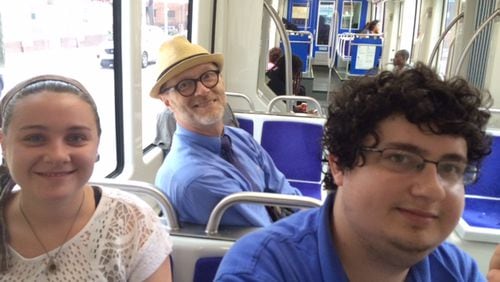Good morning, class. Today’s assignment: the Atlanta Streetcar.
You might actually hear those words in Dr. Joseph Hacker’s class at Georgia State University, where he teaches in the Andrew Young School of Policy Studies.
Hacker assigns streetcar travel partly as a way to get students “out of their books.” But there’s a bigger reason.
“I think if you’re downtown you should connect with other parts of downtown,” says Hacker, a former transit planner in the Philadelphia area.
That’s not something he finds many students doing. Typically, when he asks students how many of them take MARTA, “Two people will raise their hands.” Then he asks, how many have ridden a MARTA bus? Crickets.
“It’s easy to criticize if you don’t know anything about it,” Hacker says. “But if you experience it, it puts things in a fresh perspective.”
I recently rode the streetcar with Hacker and three GSU students to get a younger-generation perspective of the streetcar, a 2.7-mile loop from Centennial Olympic Park to the King Historic District.
Some of the things they said they like: the free fare; the smooth ride; the ability to get to Sweet Auburn Curb Market and other places for lunch; and what they call “the pinch” in the loop — the short walk between the Park Place and Woodruff stops that allows them to catch streetcars going in either direction.
Some things they dislike: long wait times of 15 minutes between cars; the lack of traffic-signal synchronization on the streets, which could speed the trip; the route’s limited reach; and the absence of real-time arrival information, to let riders know how long they have to wait before the next trip. (MARTA, for example, has made big strides in commuting convenience with the advent of its “On the Go” mobile app.)
“The lack of real-time arrival information is a big negative,” says Joey De St. Aubin, a 20-year-old public policy student. “If there’s no sign telling me when the next car is going to come, I don’t know if it’s worth it to walk or just wait. If I know it’s five minutes, I’m just going to wait. But if it’s 15 minutes, I’m going to walk. That’s something that really hampers its use for me.”
When early morning rush-hour traffic is bad, Maria Sudibjo, a Ph.D economics student, says it can take an hour to ride the streetcar from the Edgwood Hilliard stop near the King Historic District to Woodruff Park. To reduce her travel time, she adjusts her schedule and leaves home later. “It saves on gas,” she says.
Kelia Veiga, 20, takes the streetcar weekdays from her home near the King Historic District stop to school.
“I’m one of the few people it actually serves to get to your place of work, or wherever you’re going, because it doesn’t have that far of a reach,” Veiga says. “It covers only a small area, but what a lot of people don’t realize is that there’s a lot of elderly people moving around Atlanta, and a lot of disabled people, and it makes the distances much more manageable to get from place to place. I’ve noticed a lot of people like that taking advantage of the streetcar.”
Veiga sees tourists, too. “The streetcar connects them,” she says. “They may not have a car when they get to town. We’re not really mobile as a city, so it helps.” Personally, she finds the streetcar useful for traveling to and from Atlanta Hawks games, when evening traffic is congested and Uber gets too expensive with surge pricing.
Still, she wishes the system, “an awesome initiative,” better served neighborhoods “further from the center of town that have more mobility issues.” She singles out East Atlanta and South Atlanta “where, if you don’t have a car, it’s going to be hard to get to a grocery store.”
For all the talk of streetcar expansion, Hacker remains cautious. In theory, he fears the streetcar and the Atlanta Beltline may end up competing with each other.
“My concern is that there’s only so much political capital and financial will in this town, and this could create competing projects, he says. “I think the Beltline, as an economic development and mobility project, is the best use of Atlanta’s money right now for the future. I think (the streetcar) could fit in with it in that future. But I worry that it’s going to divide our attention and neither of them is going to get what they want.”
De St. Aubin also echoes what many Atlantans are thinking about the streetcar: “A lot of what I like about it is what it has the potential to be.”






